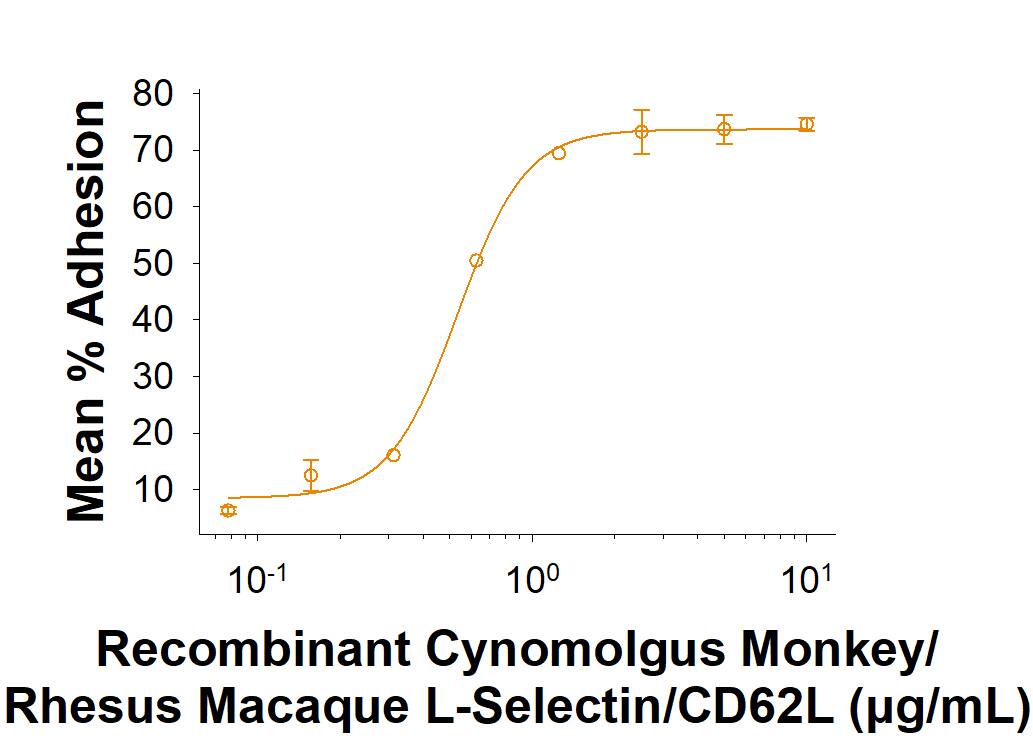Recombinant Cyno/Rhesus L-Selectin/CD62L Fc Protein, CF
R&D Systems, part of Bio-Techne | Catalog # 11192-LS

Key Product Details
Source
CHO
Accession #
Structure / Form
Disulfide-linked homodimer
Conjugate
Unconjugated
Applications
Bioactivity
Product Specifications
Source
Chinese Hamster Ovary cell line, CHO-derived L-Selectin/CD62L protein
| Recombinant Cyno/Rhesus L-Selectin (Trp52-Asn345) Accession # XP_005539996.1 |
IEGRMD | Human IgG1 (Pro100-Lys330) |
| N-terminus | C-terminus |
Purity
>95%, by SDS-PAGE visualized with Silver Staining and quantitative densitometry by Coomassie® Blue Staining.
Endotoxin Level
<0.10 EU per 1 μg of the protein by the LAL method.
N-terminal Sequence Analysis
Trp52
Predicted Molecular Mass
60 kDa
SDS-PAGE
85-95 kDa, under reducing conditions.
Activity
Measured by the ability of the immobilized protein to support the adhesion of LS180 human colorectal adenocarcinoma cells.
The ED50 for this effect is 0.300-3.60 μg/mL.
The ED50 for this effect is 0.300-3.60 μg/mL.
Scientific Data Images for Recombinant Cyno/Rhesus L-Selectin/CD62L Fc Protein, CF
Recombinant Cynomolgus Monkey/Rhesus Macaque L‑Selectin/CD62L Fc Chimera Protein Bioactivity.
Recombinant Cynomolgus Monkey/Rhesus Macaque L‑Selectin/CD62L Fc Chimera Protein (Catalog # 11192-LS) supports the adhesion LS180 human colorectal adenocarcinoma cells. The ED50 for this effect is 0.300-3.60 μg/mL.Recombinant Cynomolgus Monkey/Rhesus Macaque L‑Selectin/CD62L Fc Chimera Protein SDS-PAGE.
2 μg/lane of Recombinant Cynomolgus Monkey/Rhesus Macaque L‑Selectin/CD62L Fc Chimera Protein (Catalog # 11192-LS) was resolved with SDS-PAGE under reducing (R) and non-reducing (NR) conditions and visualized by Coomassie® Blue staining, showing bands at 85-95 kDa and 170-190 kDa, respectively.Formulation, Preparation and Storage
11192-LS
| Formulation | Supplied as a 0.2 μm filtered solution in PBS with Trehalose. |
| Shipping | The product is shipped with dry ice or equivalent. Upon receipt, store it immediately at the temperature recommended below. |
| Stability & Storage | Use a manual defrost freezer and avoid repeated freeze-thaw cycles.
|
Background: L-Selectin/CD62L
References
- Ivetic, A. et al. (2019) Front. Immunol. 10:1068.
- Grailer, J.J. et al. (2009) J. Dermatol sci. 56:141.
- Hirata, T. et al. (2015) Biochem Biophys Res. Commun. 462:371.
- Wedepohl, S. et al. (2012) Euro. J. Cell Biol. 91:257.
- Ivetic, A. et al. (2013) Inter. J. Biochem. Cell Biol. 45:550.
- Granger, D.N. and Senchenkova, E. (2010) Inflammation and the Microcirculation. San Rafael (CA): Morgan & Claypool Life Sciences Chapter 7.
- Watson, H.A. et al. (2019) Frontiers in immunology 10:1321.
Alternate Names
CD62L, hLHRc, LAM1, LECAM1, Leu-8, LNHR, LSEL, Lyam-1, LYAM1, PLNHR, SELL, TQ1
Gene Symbol
SELL
UniProt
Additional L-Selectin/CD62L Products
Product Documents for Recombinant Cyno/Rhesus L-Selectin/CD62L Fc Protein, CF
Product Specific Notices for Recombinant Cyno/Rhesus L-Selectin/CD62L Fc Protein, CF
For research use only
